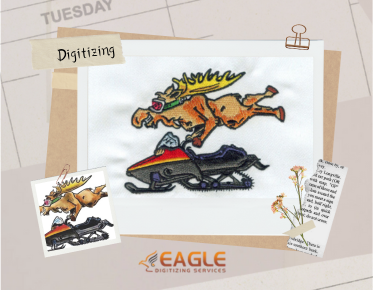Boost Performance: Optimizing Vector File Sizes Made Easy/Eagle Digitizing
Why
Vector File Size Matters
In today's digital world, efficiency is king. Vector file size plays a crucial role in the performance of your graphics. Large
vector files can bog down your systems, making them sluggish and inefficient.
By optimizing these files, you can streamline workflows, save valuable storage
space, and enhance overall performance.
The Benefits of Optimizing Vector Files
Optimizing vector files isn't just about saving space. It's about improving load times, boosting application performance, and ensuring your graphics are easy to manage and share. Efficiently optimized vector files make for smoother collaboration and quicker turnarounds on projects, which is a win-win for everyone involved.
The Impact of Large Vector Files
Slower Loading Times
Large vector files can significantly slow down
loading times, especially on the web. This can lead to poor user experiences
and even lower search engine rankings due to slower site speeds.
Increased Storage
Requirements
Bulky vector files take up more storage space,
which can be a hassle when working with limited disk space or cloud storage
quotas. Efficient file management becomes more difficult as file sizes
increase.
Performance Issues in
Applications
Applications may struggle to process large vector files, leading to performance hiccups and crashes. This can disrupt your workflow and make editing and sharing files more cumbersome.
Basic Principles of Vector Optimization
The Importance of Simplification
Simplifying your vectors is key to reducing file
size. This involves minimizing the number of anchor points and eliminating
unnecessary details that don’t contribute to the overall design.
Balancing Quality and
File Size
Optimization is a balancing act. You want to reduce file size while maintaining visual integrity. This means finding the sweet spot where your design looks great but doesn’t weigh down your system.
Tools for Vector Optimization
Popular Vector Editing
Software
Adobe Illustrator and CorelDRAW are two powerhouse
tools that offer a suite of features for vector optimization. These programs
provide comprehensive control over your designs and include built-in tools for
simplifying paths and reducing file sizes.
Online Tools for Quick
Optimization
For those in need of quick fixes, online tools
like SVGOMG (SVG Optimizer) offer instant optimization solutions. These tools
can quickly strip out unnecessary data and compress your vector files without
the need for specialized software.
Plugins and Extensions
for Optimization
Plugins like VectorFirstAid for Illustrator can automate many optimization tasks, making it easier to clean up and reduce the size of your vector files with just a few clicks.
Techniques for Reducing Vector File Size
Simplifying Paths and
Shapes
By reducing the number of anchor points and using
simpler shapes, you can significantly decrease file size. Aim for the minimal
number of points necessary to retain the intended shape.
Removing Unnecessary
Points
Extra anchor points add to file size and can
complicate your design. Use tools within your vector software to automatically
remove redundant points without altering the design.
Using Basic Shapes
Instead of Complex Paths
Whenever possible, use basic geometric shapes instead of complex, freeform paths. Simple shapes are less data-intensive and easier for software to render and process.
Optimizing Colors and Gradients
Limiting the Number of
Colors
Keeping your color palette small helps in
reducing file size. Fewer colors mean less data needs to be stored, which
translates to a lighter file.
Using Solid Colors Over
Gradients
While gradients can add depth and dimension, they
also increase file size. Opt for solid colors where possible to keep things
lean.
Reducing Gradient Steps
If gradients are necessary, reduce the number of steps in the gradient to decrease the amount of data stored. Simplifying gradients can still achieve the desired effect without bloating the file.
Efficient Use of Layers and Groups
Merging Layers and
Groups
Combining layers and groups can simplify your
file structure and reduce size. This is especially effective if certain layers
or groups don’t need to be edited separately.
Removing Hidden and
Unused Layers
Hidden or unused layers add unnecessary bulk to
your files. Regularly clean out these layers to keep your files streamlined and
efficient.
Flattening Layers for
Simplicity
Flattening layers, where appropriate, can reduce complexity and size. However, be mindful of losing editability if future adjustments are needed.
Optimizing Text in Vector Files
Converting Text to
Outlines
Converting text to outlines can prevent
compatibility issues and reduce file size. This is particularly useful when
sharing files across different systems and software.
Using System Fonts vs.
Custom Fonts
System fonts are typically less data-heavy than
custom fonts. If the design allows, use system fonts to keep your file sizes
down.
Reducing Text Size and
Complexity
Simplifying text by reducing its size or complexity can help minimize file size. Avoid overly complex fonts and keep text elements straightforward.
Working with Images in Vector Files
Linking vs. Embedding
Images
Linking images rather than embedding them can
keep your vector file sizes smaller. However, ensure linked images are easily
accessible to avoid broken links.
Reducing Image Resolution
Lowering the resolution of embedded images can
significantly cut down file size. Choose a resolution that maintains quality
without being excessively high.
Using Image Compression
Techniques
Compressing images before embedding them in your vector files can also help reduce overall file size. Tools like JPEGmini or TinyPNG can be useful for this purpose.
Simplifying Effects and Styles
Reducing the Use of
Effects
Effects like shadows, glows, and blurs can add
substantial data to your files. Use these sparingly to keep file sizes
manageable.
Using Simple Styles Over
Complex Ones
Opt for simple styles that achieve the desired
look without unnecessary complexity. This not only reduces file size but also
makes your designs easier to edit.
Flattening Effects for Optimization
Flattening effects can help optimize files, though it should be done with caution to ensure you don’t lose the ability to make necessary edits later.
Advanced Optimization Techniques
Subsetting and Cleaning
Up Fonts
Subsetting fonts to include only the characters
you need can significantly reduce file size. Cleaning up fonts by removing
unnecessary glyphs also helps.
Utilizing Symbol and
Reuse Techniques
Using symbols and reusable elements can save
space by reducing redundancy. Define commonly used elements as symbols to cut
down on overall data.
Implementing Clipping
Masks Wisely
Clipping masks can simplify your designs but use them judiciously. Overuse can lead to complex files that are harder to manage and edit.
Automating the Optimization Process
Batch Processing for
Multiple Files
Batch processing tools can save time when
optimizing multiple files. Programs like Adobe Bridge offer batch operations
that can apply the same optimization settings across numerous files.
Scripts and Macros for
Automation
Scripts and macros can automate repetitive tasks,
making the optimization process more efficient. Custom scripts can be written
to streamline specific optimization tasks tailored to your workflow.
Using Optimization
Presets
Many vector editing programs offer optimization presets. These presets provide a quick way to apply a set of predefined optimization settings, ensuring consistency across your files.
Common Pitfalls and How to Avoid Them
Over-simplification
Leading to Quality Loss
While simplification is crucial, overdoing it can
lead to a loss of quality. Strive to maintain a balance where the design
remains intact and visually appealing.
Ignoring File
Compatibility Issues
Ensure your optimized files remain compatible
with different software and systems. Testing files in various environments can
help prevent compatibility issues.
Mismanaging Original
Files
Always keep a backup of the original files before optimization. This ensures you can revert to the unoptimized version if needed, preserving the integrity of your work.
Testing and Validating Optimized Files
Comparing File Sizes
Before and After
Regularly compare file sizes before and after
optimization to gauge the effectiveness of your efforts. This helps in
understanding the impact of different techniques.
Ensuring Visual
Consistency
Ensure that visual consistency is maintained
post-optimization. Side-by-side comparisons can help identify any unintended
alterations.
Performance Testing in
Different Applications
Test the performance of your optimized files in various applications to ensure they load quickly and run smoothly. This is particularly important for web graphics and interactive designs.
Best Practices for Maintaining Optimized Files
Regularly Reviewing and
Updating Files
Regularly review and update your files to
incorporate new optimization techniques and keep your designs current.
Documenting Optimization
Steps
Documenting the steps taken during optimization
can be valuable for future reference. This helps in maintaining a consistent
optimization process.
Educating Team Members
on Optimization Techniques
Share optimization knowledge with team members to ensure everyone is on the same page. Collaborative learning can lead to more efficient workflows and better-optimized files.
The Future of Vector File Optimization
Emerging Trends and
Technologies
Stay informed about emerging trends and
technologies in vector file optimization. Advancements in software and
techniques can offer new ways to streamline your workflow.
Predictions for Vector
Graphics Efficiency
As technology evolves, vector graphics are likely to become even more efficient. Predicting and preparing for these changes can keep you ahead of the curve.
Optimizing vector file size is essential for
improving performance and efficiency. From basic principles to advanced
techniques, effective optimization can significantly enhance your design
process.
Start optimizing your vector files today to reap
the benefits of faster performance, reduced storage needs, and more efficient
workflows. The time invested in learning and applying these techniques will pay
off in smoother, more effective design projects.



